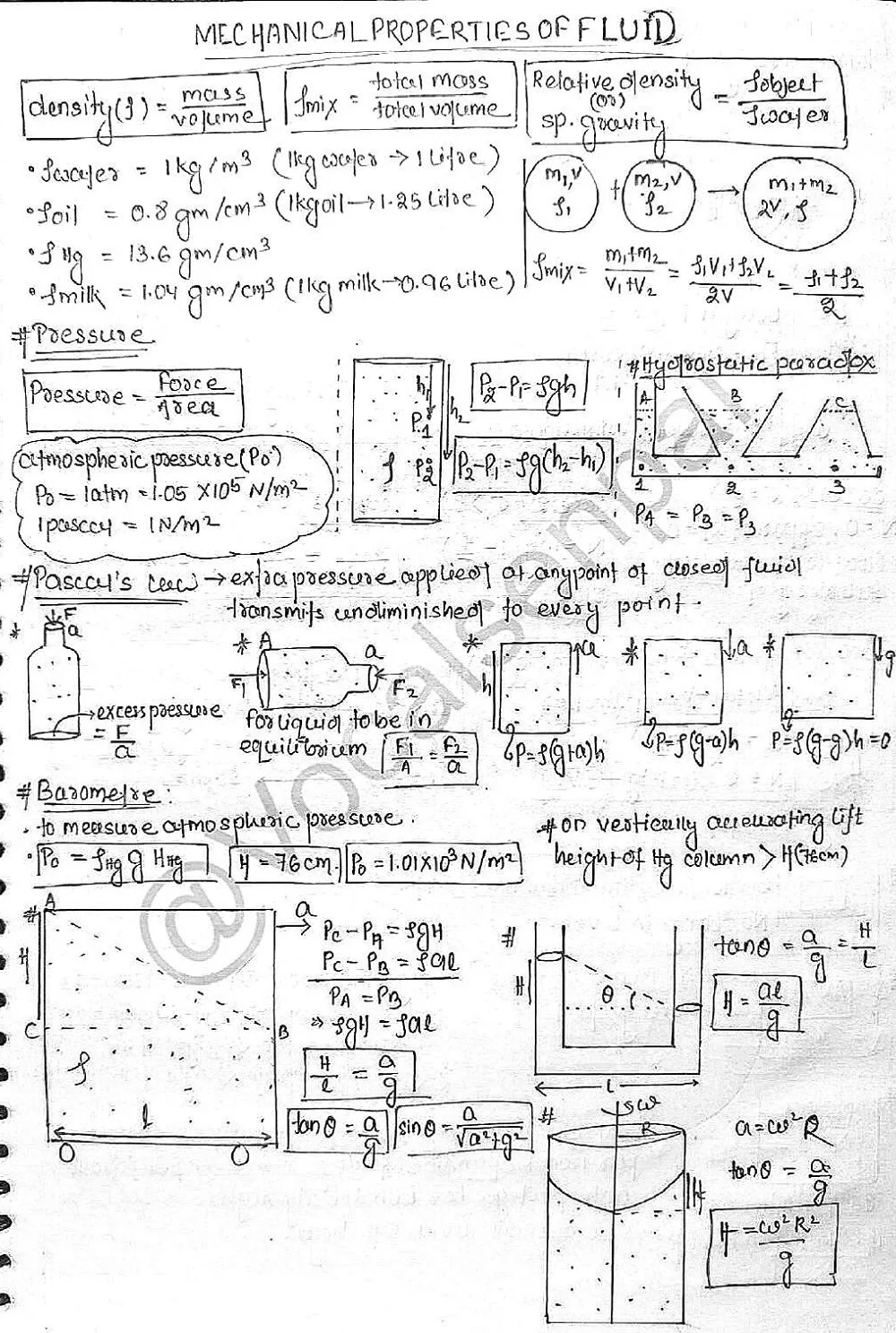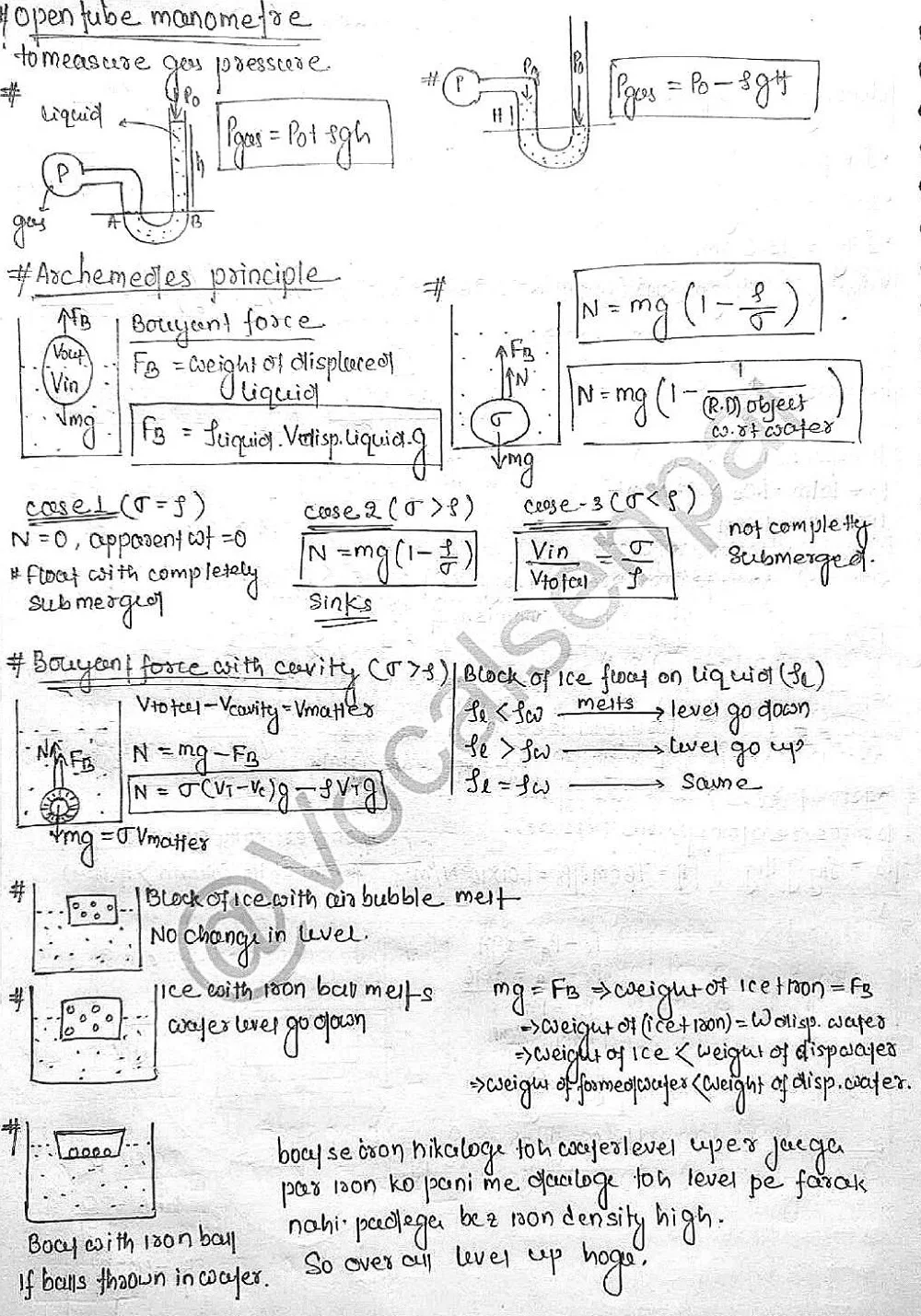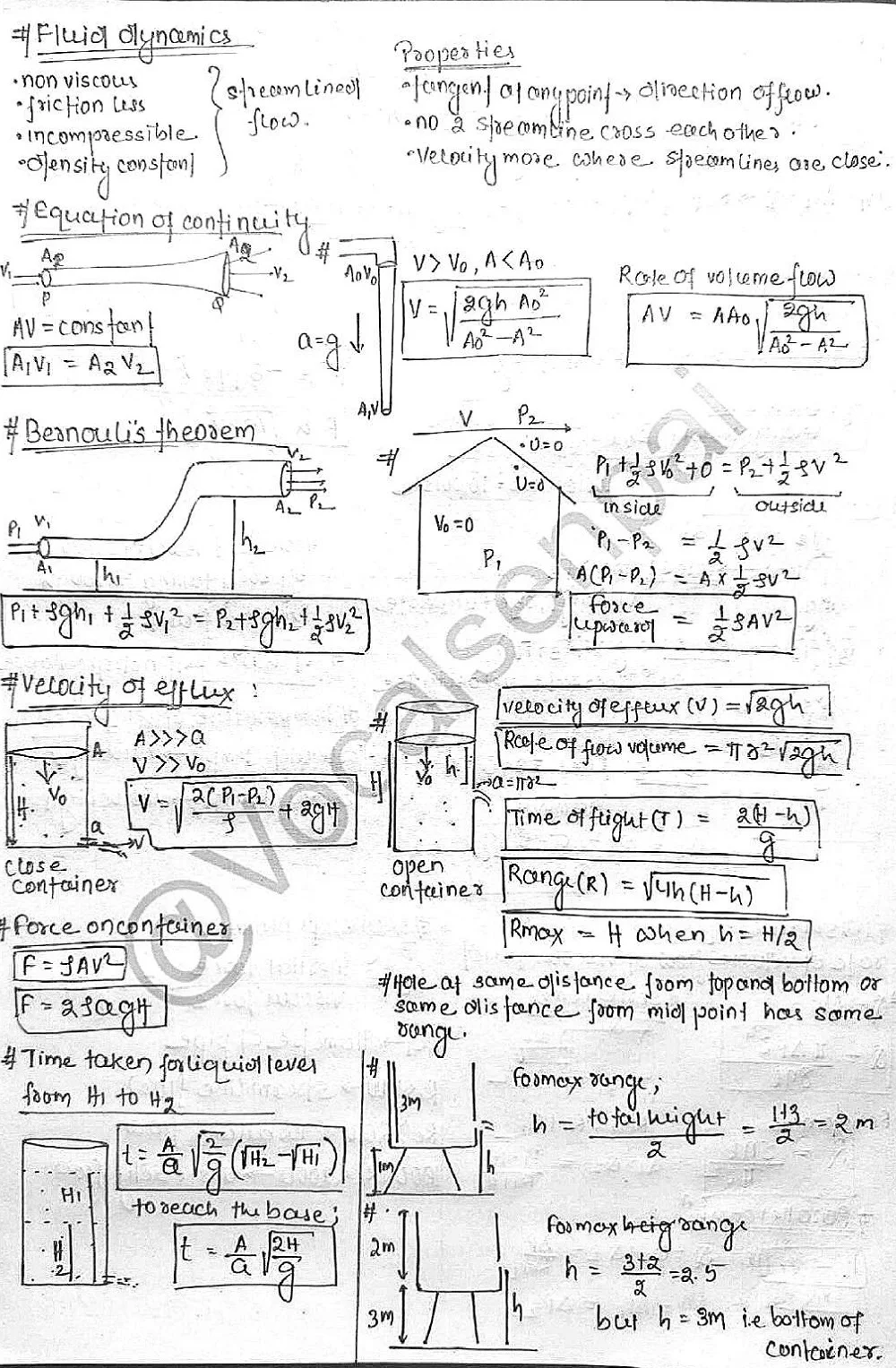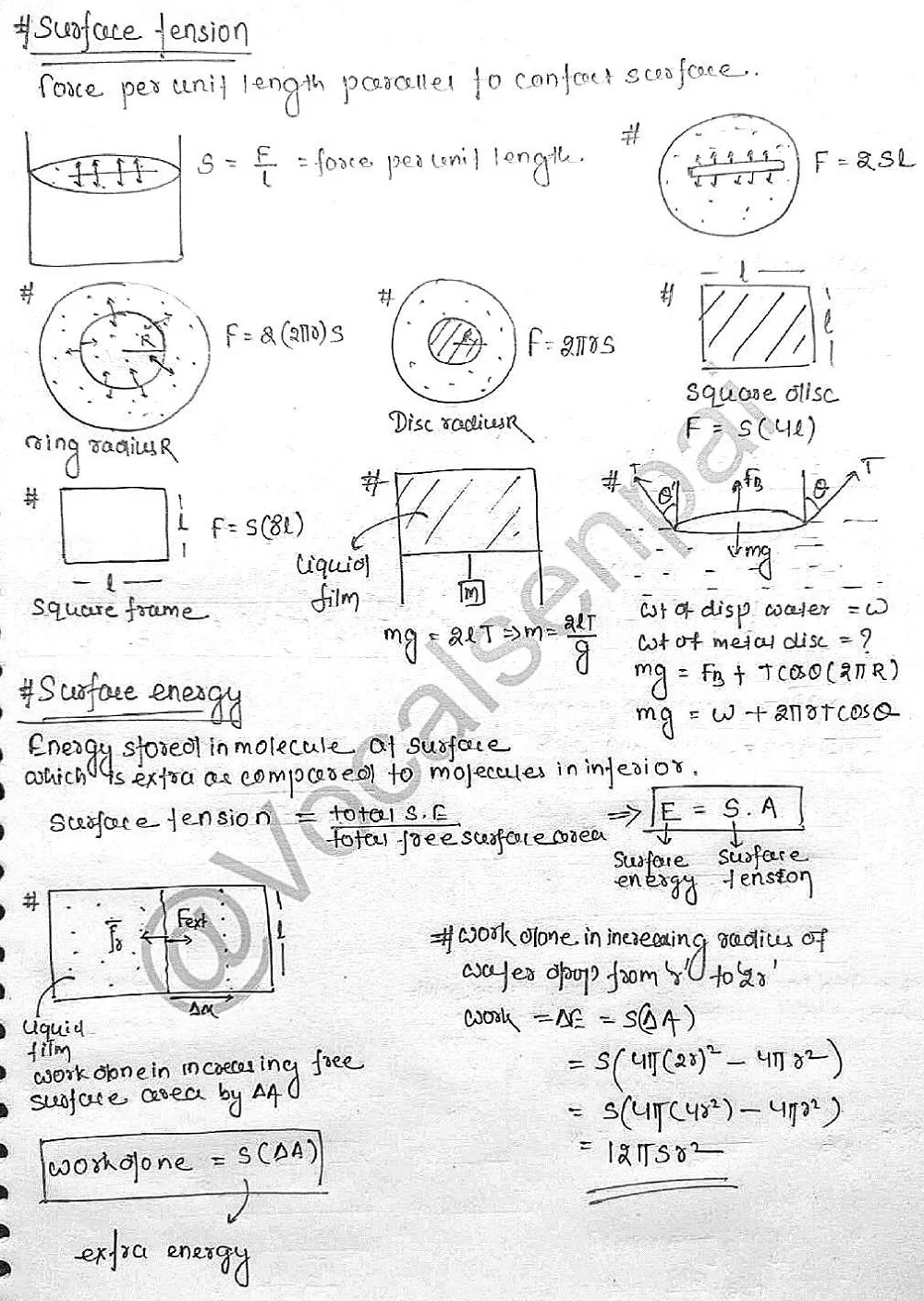Fluid Mechanics - Fluids are a fundamental part of our world, encompassing both liquids and gases. They play a crucial role in various natural phenomena and technological advancements. This chapter in Class 11 Physics delves into the fascinating realm of Fluid Mechanics, exploring the properties and behavior of these ever-flowing substances.
Definition of Fluids
Fluids are substances that lack a rigid shape of their own and readily deform under applied shear stress. Unlike solids, which can resist deformation, fluids yield to pressure and adapt to the shape of their container. This inherent fluidity arises from the weak intermolecular forces between the constituent particles of liquids and gases.
Types of Fluids
Fluids can be broadly categorized into two main types:
⦿ Liquids: These fluids have a definite volume but take the shape of their container. They are nearly incompressible, meaning their density remains relatively constant under pressure variations. Examples of liquids include water, oil, and blood.
⦿ Gases: Gases are highly compressible fluids that can expand to fill their container entirely. They have no definite shape or volume and exhibit negligible intermolecular forces. Examples of gases include air, oxygen, and helium.
Examples of Fluid Applications
The principles of Fluid Mechanics find application in a vast array of fields:
⦿ Hydraulics: This branch of engineering utilizes fluids to transmit power and perform mechanical work. Hydraulic brakes in automobiles and hydraulic lifts are prime examples.
⦿ Aerodynamics: The study of how air interacts with moving objects forms the basis of aerodynamics. It plays a vital role in aircraft design, ensuring efficient flight.
⦿ Hydrodynamics: This field focuses on the motion of fluids, with applications in shipbuilding, designing pipelines, and understanding fluid flow within the human body.
Formula Table for Fluid Mechanics
⦿ Pressure (P): P = F/A (Force (F) divided by Area (A))
⦿ Density (ρ): ρ = m/V (Mass (m) divided by Volume (V))
⦿ Archimedes' Principle: Buoyant Force = Weight of Displaced Fluid (useful for understanding upthrust experienced by submerged objects)
⦿ Bernoulli's Principle: P + ½ρv² = constant (relates pressure, density, and velocity of a fluid flow)
⦿ Viscosity (η): η = (Shear Stress) / (Rate of Shear Strain) (measures a fluid's resistance to flow)
By understanding these concepts and formulas, you'll gain a deeper appreciation for the world of fluids, from the everyday experience of pouring water to the marvels of modern aviation.
Fluid Mechanics FAQs
1. What's the difference between liquids and gases?
Liquids have a definite volume and take the shape of their container, while gases are compressible and expand to fill their container entirely. Liquids are also nearly incompressible, meaning their density changes minimally with pressure, while gases can significantly change density under pressure variations.
2. Can all fluids flow easily?
Fluids can exhibit resistance to flow, known as viscosity. Honey has a higher viscosity than water, making it flow slower.
3. What's pressure all about in fluids?
Pressure is the force exerted per unit area by a fluid. Imagine tiny needles pushing outwards in all directions within the fluid. The deeper you go in a fluid, the greater the pressure due to the weight of the fluid above.
4. How does buoyancy work?
Archimedes' Principle explains buoyancy. When an object is submerged in a fluid, it experiences an upward force called buoyant force. This force is equal to the weight of the fluid displaced by the object. This is why objects like boats can float!
5. What's Bernoulli's Principle? How is it used?
Bernoulli's Principle states that for an incompressible, inviscid fluid in steady flow, the sum of pressure (P), kinetic energy per unit volume (½ρv²), and potential energy per unit volume (ρgh) remains constant along a streamline (path followed by a fluid particle). This principle is used in airplane wings. The curved upper surface of the wing creates a higher velocity on the top, resulting in lower pressure there. This pressure difference generates lift, allowing the airplane to fly.
6. Why are fluids important?
Fluids are all around us, from the air we breathe to the blood flowing in our bodies. Fluid mechanics helps us understand and utilize these fluids in various applications, like designing efficient pumps, understanding weather patterns, and even developing new medical technologies.



![Fluid - Physics Short Handwritten Notes [PDF]📚 Fluid - Physics Short Handwritten Notes [PDF]📚](https://blogger.googleusercontent.com/img/b/R29vZ2xl/AVvXsEjbQkh1JF-CiZL6TLm0Y19dlT2KyUUmeYtd_jfJXdjdFczFnWLEKIifAteDS1rXXQ1zE_M_PegA2Bbca2RvQM_OTseg_gDDQxR_HR1VLcLDLzOtPQYOJD3tf5sS150E62xsO593ro-pbM3l0i_zixfRfI1ml9VKqiWt0ZUZucvy52xfHWwEtV_Szwfsk-o/s16000-rw/Fluid%20-%20Physics%20Short%20Handwritten%20Notes%20%5BPDF%5D%F0%9F%93%9A-images-0.jpg)
![Fluid - Physics Short Handwritten Notes [PDF]📚 Fluid - Physics Short Handwritten Notes [PDF]📚](https://blogger.googleusercontent.com/img/b/R29vZ2xl/AVvXsEiu-vgYgSoJI_7r_obL1tiBWa1SdehBuBrBi0WAijy5r0cKk2tBxga9buH6XZIseV0xoTU4gslv2ExTu-vo848Q-6KKNXUdEzg9EAHEK17KB2S9Ewa9Viwruq4j3VzWlxRvXYXRIBbrZafOVNRFBhDt57iESpwer-EhQ20VmjPokmetzvL3bd1VnG-MLNQ/s16000-rw/Fluid%20-%20Physics%20Short%20Handwritten%20Notes%20%5BPDF%5D%F0%9F%93%9A-images-1.jpg)






